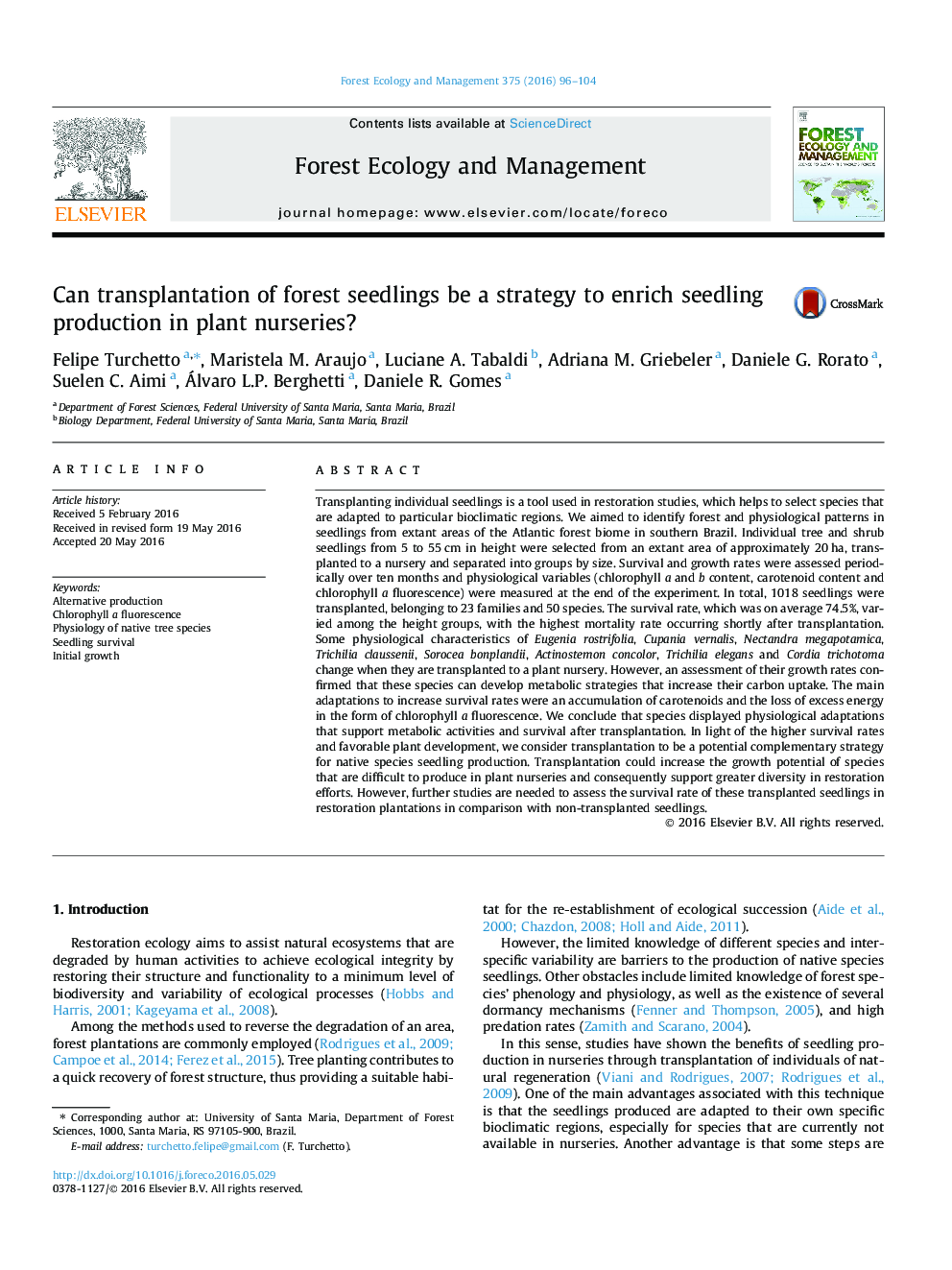| کد مقاله | کد نشریه | سال انتشار | مقاله انگلیسی | نسخه تمام متن |
|---|---|---|---|---|
| 6542179 | 159147 | 2016 | 9 صفحه PDF | دانلود رایگان |
عنوان انگلیسی مقاله ISI
Can transplantation of forest seedlings be a strategy to enrich seedling production in plant nurseries?
ترجمه فارسی عنوان
پیوند گیاهان جنگل می تواند یک استراتژی برای غنی سازی تولید گیاهچه در مهد کودک باشد؟
دانلود مقاله + سفارش ترجمه
دانلود مقاله ISI انگلیسی
رایگان برای ایرانیان
کلمات کلیدی
تولید جایگزین، کلروفیل یک فلورسانس، فیزیولوژی گونه های درخت بومی، بقاء نهال، رشد اولیه،
موضوعات مرتبط
علوم زیستی و بیوفناوری
علوم کشاورزی و بیولوژیک
بوم شناسی، تکامل، رفتار و سامانه شناسی
چکیده انگلیسی
Transplanting individual seedlings is a tool used in restoration studies, which helps to select species that are adapted to particular bioclimatic regions. We aimed to identify forest and physiological patterns in seedlings from extant areas of the Atlantic forest biome in southern Brazil. Individual tree and shrub seedlings from 5 to 55Â cm in height were selected from an extant area of approximately 20Â ha, transplanted to a nursery and separated into groups by size. Survival and growth rates were assessed periodically over ten months and physiological variables (chlorophyll a and b content, carotenoid content and chlorophyll a fluorescence) were measured at the end of the experiment. In total, 1018 seedlings were transplanted, belonging to 23 families and 50 species. The survival rate, which was on average 74.5%, varied among the height groups, with the highest mortality rate occurring shortly after transplantation. Some physiological characteristics of Eugenia rostrifolia, Cupania vernalis, Nectandra megapotamica, Trichilia claussenii, Sorocea bonplandii, Actinostemon concolor, Trichilia elegans and Cordia trichotoma change when they are transplanted to a plant nursery. However, an assessment of their growth rates confirmed that these species can develop metabolic strategies that increase their carbon uptake. The main adaptations to increase survival rates were an accumulation of carotenoids and the loss of excess energy in the form of chlorophyll a fluorescence. We conclude that species displayed physiological adaptations that support metabolic activities and survival after transplantation. In light of the higher survival rates and favorable plant development, we consider transplantation to be a potential complementary strategy for native species seedling production. Transplantation could increase the growth potential of species that are difficult to produce in plant nurseries and consequently support greater diversity in restoration efforts. However, further studies are needed to assess the survival rate of these transplanted seedlings in restoration plantations in comparison with non-transplanted seedlings.
ناشر
Database: Elsevier - ScienceDirect (ساینس دایرکت)
Journal: Forest Ecology and Management - Volume 375, 1 September 2016, Pages 96-104
Journal: Forest Ecology and Management - Volume 375, 1 September 2016, Pages 96-104
نویسندگان
Felipe Turchetto, Maristela M. Araujo, Luciane A. Tabaldi, Adriana M. Griebeler, Daniele G. Rorato, Suelen C. Aimi, Álvaro L.P. Berghetti, Daniele R. Gomes,
